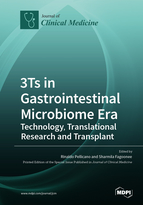3Ts in Gastrointestinal Microbiome Era: Technology, Translational Research and Transplant
A special issue of Journal of Clinical Medicine (ISSN 2077-0383). This special issue belongs to the section "Gastroenterology & Hepatopancreatobiliary Medicine".
Deadline for manuscript submissions: closed (31 July 2020) | Viewed by 60234
Special Issue Editors
Interests: Helicobacter pylori; dyspepsia; irritable bowel syndrome; pancreatitis; liver diseases; hepatitis C; steatohepatitis; microbioma; microbiota; peptic ulcer; inflammatory bowed diseases; gastrointestinal cancer
Interests: correction of metabolic diseases of liver with stem cells as platform for gene therapy; liver diseases and extracellular vesicles: search for new therapies and biomarkers
Special Issues, Collections and Topics in MDPI journals
Special Issue Information
Dear Colleagues,
We have entered a new era where some concepts of the complex community of microorganisms (microbiota comprising bacteria, fungi, viruses, bacteriophages and helminths) are being re-discovered and re-visited. Microbiota and human interaction is not new; they have shared a long history of co-existence. Nevertheless, the opportunities to understand the role of these microorganisms in human diseases and to design a potential treatment were limited. At present, thanks to development of innovative and cutting-edge molecular biological and microbiological technologies as well as clinical informatics and bioinformatics skills, microbiome application is moving into clinics. Approaches to therapy based on prebiotics, probiotics and lately on fecal microbiota transplantation has revolutionized medicine. Microbiota outnumbers our genes and is now regarded as another organ of the body. The gastrointestinal tract and gut microbiota display a well-documented symbiotic relationship. Disruption of intestinal microbiota homeostasis—called dysbiosis—has been associated with several diseases. Whether dysbiosis is a cause or consequence of disease initiation and progression still needs to be investigated in more depth. The aim of this Special Issue is to highlight recent advances in the field of microbiome research which are now shaping medicine and current approaches to microbiome-oriented therapy for gastrointestinal diseases.
Dr. Rinaldo Pellicano
Dr. Sharmila Fagoonee
Guest Editors
Manuscript Submission Information
Manuscripts should be submitted online at www.mdpi.com by registering and logging in to this website. Once you are registered, click here to go to the submission form. Manuscripts can be submitted until the deadline. All submissions that pass pre-check are peer-reviewed. Accepted papers will be published continuously in the journal (as soon as accepted) and will be listed together on the special issue website. Research articles, review articles as well as short communications are invited. For planned papers, a title and short abstract (about 100 words) can be sent to the Editorial Office for announcement on this website.
Submitted manuscripts should not have been published previously, nor be under consideration for publication elsewhere (except conference proceedings papers). All manuscripts are thoroughly refereed through a single-blind peer-review process. A guide for authors and other relevant information for submission of manuscripts is available on the Instructions for Authors page. Journal of Clinical Medicine is an international peer-reviewed open access semimonthly journal published by MDPI.
Please visit the Instructions for Authors page before submitting a manuscript. The Article Processing Charge (APC) for publication in this open access journal is 2600 CHF (Swiss Francs). Submitted papers should be well formatted and use good English. Authors may use MDPI's English editing service prior to publication or during author revisions.
Keywords
- Diseases of the gastrointestinal tract
- In vitro assays and translational studies
- Healthy and pathogenic microbiota
- Microbiome-host interaction
- Nutrition, microbial products and functionality in gastrointestinal diseases
- Clinical interventions and fecal microbiota transplant
- Technological advances in microbiota characterization
- Extracellular vesicles
- Biomarkers








